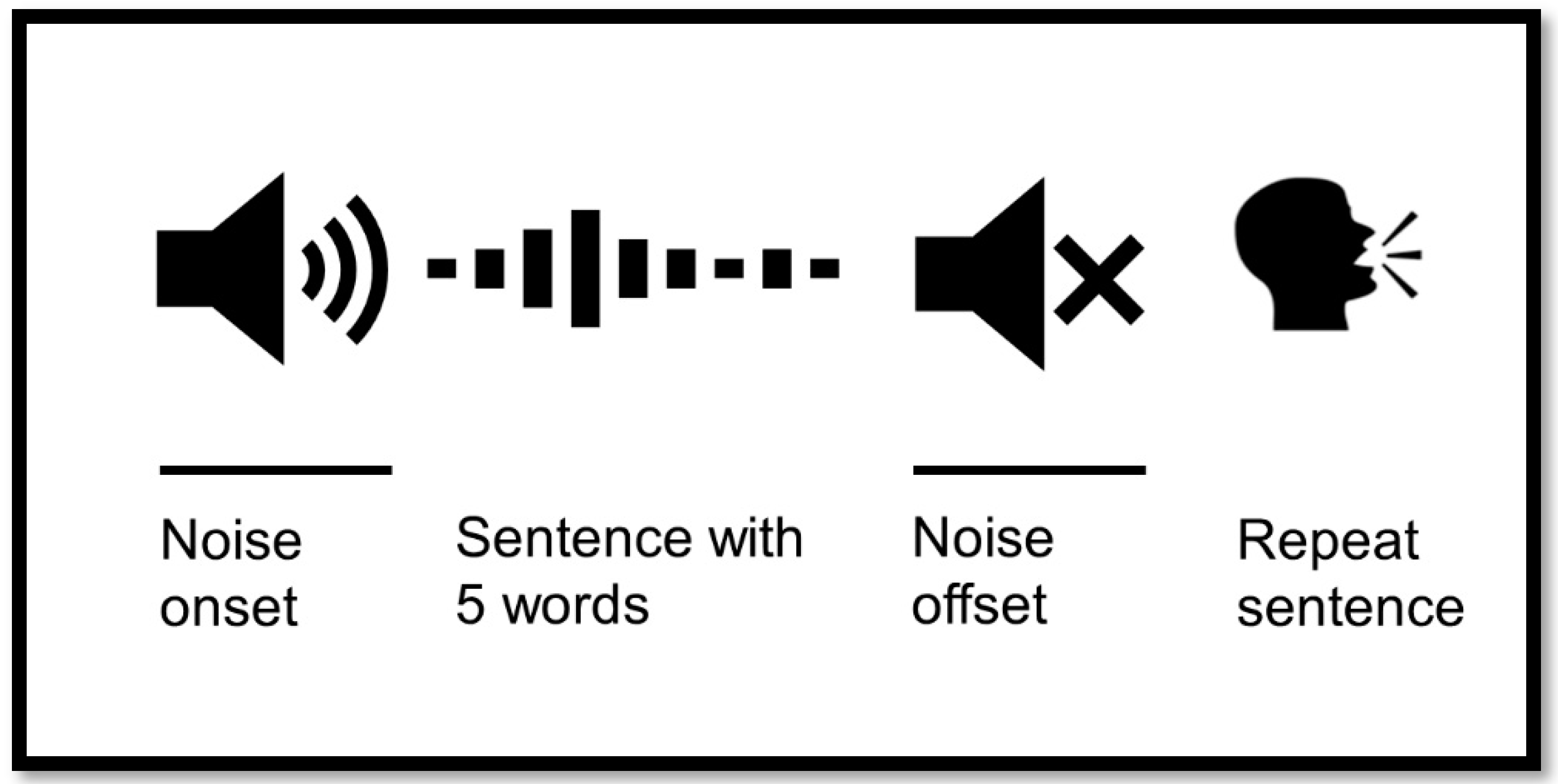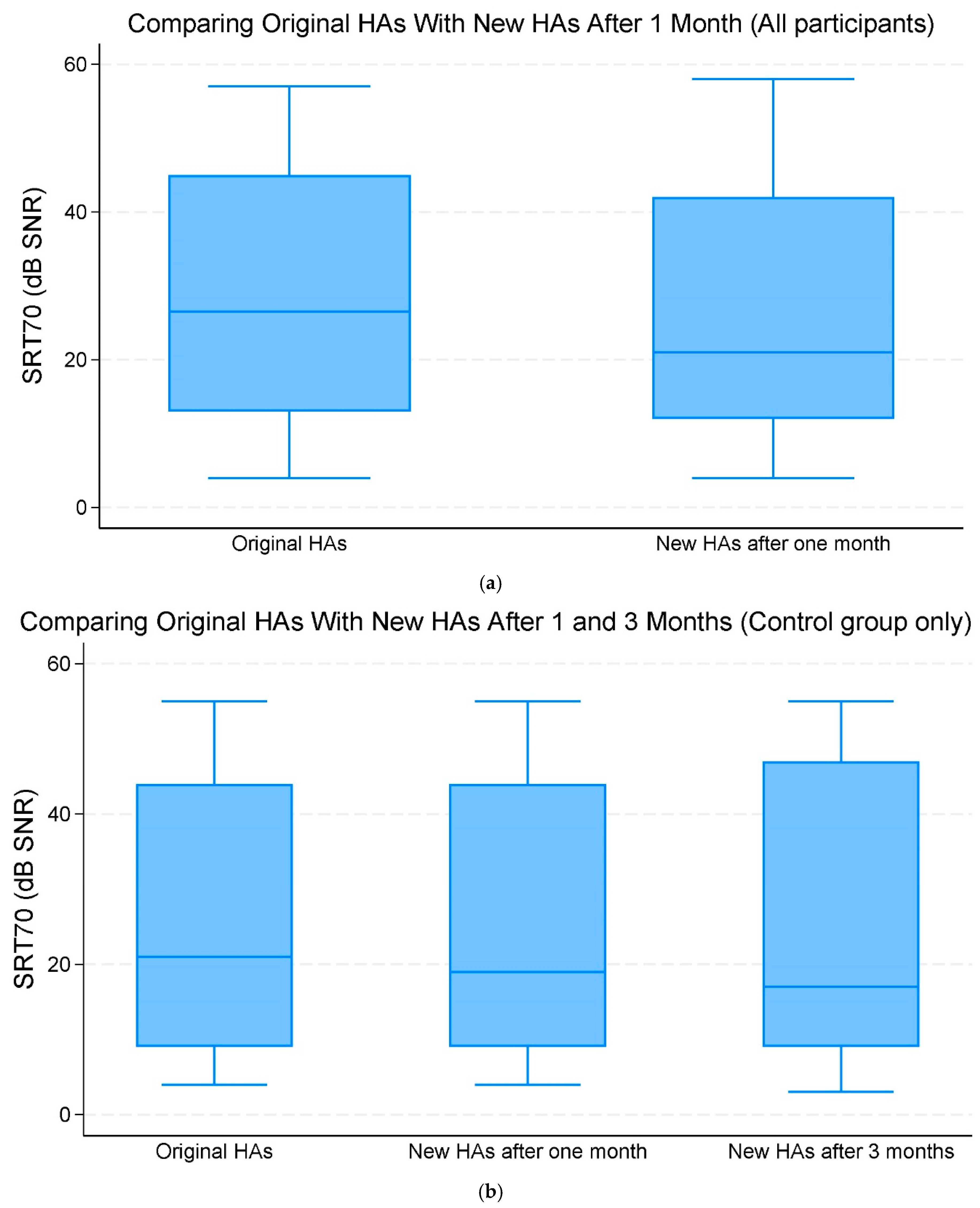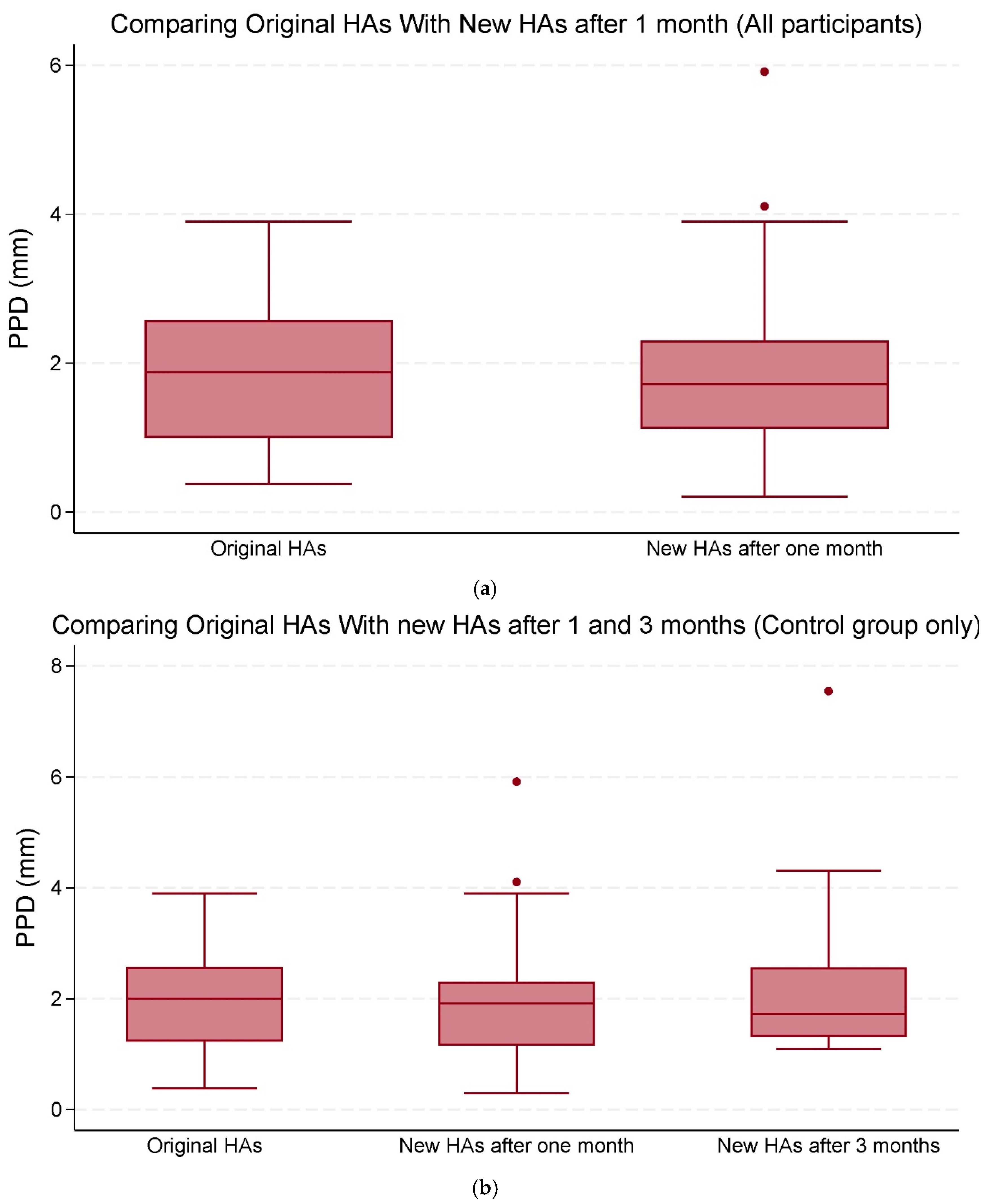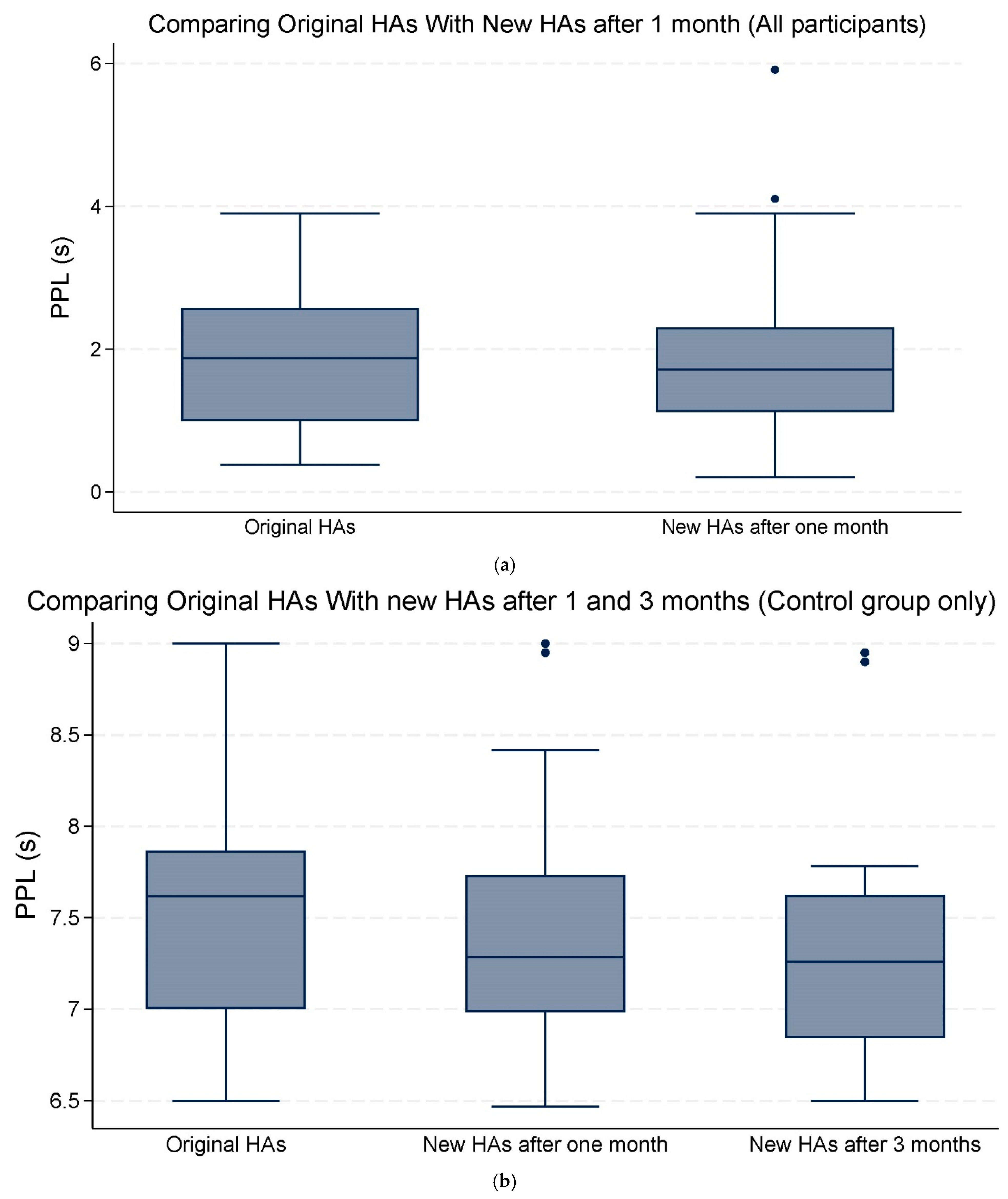Evaluation of Replacement Hearing Aids in Cochlear Implant Candidates Using the Hearing in Noise Test (HINT) and Pupillometry
Abstract
1. Introduction
1.1. Listening Effort
1.2. Pupillometry
1.3. Hearing in Noise Test
1.4. Objective
2. Materials and Methods
2.1. Participants
2.2. Apparatus and Procedure
2.3. Replacement of Hearing Aids
2.4. Data Analyses
2.5. Statistics
3. Results
4. Discussion
Strengths and Limitations
5. Conclusions
Author Contributions
Funding
Institutional Review Board Statement
Informed Consent Statement
Data Availability Statement
Conflicts of Interest
References
- van Loon, M.C.; Smits, C.; Smit, C.F.; Hensen, E.F.; Merkus, P. Cochlear Implantation in Adults With Asymmetric Hearing Loss: Benefits of Bimodal Stimulation. Otol. Neurotol. 2017, 38, e100–e106. [Google Scholar] [CrossRef] [PubMed]
- Holtmann, L.C.; Janosi, A.; Bagus, H.; Scholz, T.; Lang, S.; Arweiler-Harbeck, D.; Hans, S. Aligning Hearing Aid and Cochlear Implant Improves Hearing Outcome in Bimodal Cochlear Implant Users. Otol. Neurotol. 2020, 41, 1350–1356. (In English) [Google Scholar] [CrossRef]
- Ching, T.Y.; van Wanrooy, E.; Dillon, H. Binaural-bimodal fitting or bilateral implantation for managing severe to profound deafness: A review. Trends Amplif. 2007, 11, 161–192. (In English) [Google Scholar] [CrossRef] [PubMed]
- SSheffield, W.; Gifford, R.H. The benefits of bimodal hearing: Effect of frequency region and acoustic bandwidth. Audiol. Neurootol. 2014, 19, 151–163. (In English) [Google Scholar] [CrossRef]
- Huth, M.E.; Boschung, R.L.; Caversaccio, M.D.; Wimmer, W.; Georgios, M. The effect of internet telephony and a cochlear implant accessory on mobile phone speech comprehension in cochlear implant users. Eur. Arch. Otorhinolaryngol. 2022, 279, 5547–5554. (In English) [Google Scholar] [CrossRef]
- National Institute of Care Excellence (NICE). Cochlear Implants for Children and Adults with Severe to Profound Deafness. 2019. Available online: https://www.nice.org.uk/guidance/ta566 (accessed on 23 January 2025).
- Vroegop, J.L.; Dingemanse, J.G.; van der Schroeff, M.P.; Goedegebure, A. Comparing the Effect of Different Hearing Aid Fitting Methods in Bimodal Cochlear Implant Users. Am. J. Audiol. 2019, 28, 1–10. (In English) [Google Scholar] [CrossRef] [PubMed]
- Dunn, C.C.; Tyler, R.S.; Oakley, S.; Gantz, B.J.; Noble, W. Comparison of speech recognition and localization performance in bilateral and unilateral cochlear implant users matched on duration of deafness and age at implantation. Ear Hear. 2008, 29, 352–359. (In English) [Google Scholar] [CrossRef] [PubMed]
- Boisvert, I.; McMahon, C.M.; Dowell, R.C.; Lyxell, B. Long-term asymmetric hearing affects cochlear implantation outcomes differently in adults with pre- and postlingual hearing loss. PLoS ONE 2015, 10, e0129167. (In English) [Google Scholar] [CrossRef] [PubMed]
- Day, G.A.; Browning, G.G.; Gatehouse, S. Benefit from binaural hearing aids in individuals with a severe hearing impairment. Br. J. Audiol. 1988, 22, 273–277. (In English) [Google Scholar] [CrossRef] [PubMed]
- Hoppe, U.; Hocke, T.; Hast, A.; Iro, H. Cochlear Implantation in Candidates With Moderate-to-Severe Hearing Loss and Poor Speech Perception. Laryngoscope 2021, 131, E940–E945. (In English) [Google Scholar] [CrossRef]
- Balkenhol, T.; Wallhäusser-Franke, E.; Rotter, N.; Servais, J.J. Cochlear Implant and Hearing Aid: Objective Measures of Binaural Benefit. Front. Neurosci. 2020, 14, 586119. (In English) [Google Scholar] [CrossRef]
- Keilmann, A.M.; Bohnert, A.M.; Gosepath, J.; Mann, W.J. Cochlear implant and hearing aid: A new approach to optimizing the fitting in this bimodal situation. Eur. Arch. Otorhinolaryngol. 2009, 266, 1879–1884. (In English) [Google Scholar] [CrossRef] [PubMed]
- Ching, T.Y.; Incerti, P.; Hill, M. Binaural benefits for adults who use hearing aids and cochlear implants in opposite ears. Ear Hear. 2004, 25, 9–21. (In English) [Google Scholar] [CrossRef]
- Holden, L.K.; Finley, C.C.; Firszt, J.B.; Holden, T.A.; Brenner, C.; Potts, L.G.; Gotter, B.D.; Vanderhoof, S.S.; Mispagel, K.; Heydebrand, G.; et al. Factors affecting open-set word recognition in adults with cochlear implants. Ear Hear. 2013, 34, 342–360. (In English) [Google Scholar] [CrossRef] [PubMed]
- Pichora-Fuller, M.K.; Kramer, S.E.; Eckert, M.A.; Edwards, B.; Hornsby, B.W.; Humes, L.E.; Lemke, U.; Lunner, T.; Matthen, M.; Mackersie, C.L.; et al. Hearing Impairment and Cognitive Energy: The Framework for Understanding Effortful Listening (FUEL). Ear Hear. 2016, 37 (Suppl. S1), 5s–27s. (In English) [Google Scholar] [CrossRef] [PubMed]
- EDevocht, M.J.; Janssen, A.M.L.; Chalupper, J.; Stokroos, R.J.; George, E.L.J. The Benefits of Bimodal Aiding on Extended Dimensions of Speech Perception: Intelligibility, Listening Effort, and Sound Quality. Trends Hear. 2017, 21, 2331216517727900. (In English) [Google Scholar] [CrossRef]
- Winn, M.B.; Edwards, J.R.; Litovsky, R.Y. The Impact of Auditory Spectral Resolution on Listening Effort Revealed by Pupil Dilation. Ear Hear. 2015, 36, e153–e165. [Google Scholar] [CrossRef]
- Alhanbali, S.; Munro, K.J.; Dawes, P.; Carolan, P.J.; Millman, R.E. Dimensions of self-reported listening effort and fatigue on a digits-in-noise task, and association with baseline pupil size and performance accuracy. Int. J. Audiol. 2021, 60, 762–772. (In English) [Google Scholar] [CrossRef] [PubMed]
- Hétu, R.; Riverin, L.; Lalande, N.; Getty, L.; St-Cyr, C. Qualitative analysis of the handicap associated with occupational hearing loss. Br. J. Audiol. 1988, 22, 251–264. (In English) [Google Scholar] [CrossRef]
- Hornsby, B.W.; Naylor, G.; Bess, F.H. A Taxonomy of Fatigue Concepts and Their Relation to Hearing Loss. Ear Hear. 2016, 37 (Suppl. S1), 136s–144s. (In English) [Google Scholar] [CrossRef]
- McGarrigle, R.; Munro, K.J.; Dawes, P.; Stewart, A.J.; Moore, D.R.; Barry, J.G.; Amitay, S. Listening effort and fatigue: What exactly are we measuring? A British Society of Audiology Cognition in Hearing Special Interest Group ‘white paper’. Int. J. Audiol. 2014, 53, 433–440. (In English) [Google Scholar] [CrossRef] [PubMed]
- Ohlenforst, B.; Zekveld, A.A.; Jansma, E.P.; Wang, Y.; Naylor, G.; Lorens, A.; Lunner, T.; Kramer, S.E. Effects of Hearing Impairment and Hearing Aid Amplification on Listening Effort: A Systematic Review. Ear Hear. 2017, 38, 267–281. (In English) [Google Scholar] [CrossRef]
- Pichora-Fuller, M.K. How Social Psychological Factors May Modulate Auditory and Cognitive Functioning During Listening. Ear Hear. 2016, 37 (Suppl. S1), 92s–100s. (In English) [Google Scholar] [CrossRef] [PubMed]
- Winn, M.B.; Wendt, D.; Koelewijn, T.; Kuchinsky, S.E. Best Practices and Advice for Using Pupillometry to Measure Listening Effort: An Introduction for Those Who Want to Get Started. Trends Hear. 2018, 22, 2331216518800869. [Google Scholar] [CrossRef]
- Kahneman, D. Attention and Effort; Prentice-Hal: Englewood Cliffs, NJ, USA, 1973. [Google Scholar]
- Zekveld, A.A.; Kramer, S.E.; Festen, J.M. Cognitive load during speech perception in noise: The influence of age, hearing loss, and cognition on the pupil response. Ear Hear. 2011, 32, 498–510. (In English) [Google Scholar] [CrossRef] [PubMed]
- Zekveld, A.A.; Koelewijn, T.; Kramer, S.E. The Pupil Dilation Response to Auditory Stimuli: Current State of Knowledge. Trends Hear. 2018, 22, 2331216518777174. (In English) [Google Scholar] [CrossRef]
- Russo, F.Y.; Hoen, M.; Karoui, C.; Demarcy, T.; Ardoint, M.; Tuset, M.P.; De Seta, D.; Sterkers, O.; Lahlou, G.; Mosnier, I. Pupillometry Assessment of Speech Recognition and Listening Experience in Adult Cochlear Implant Patients. Front. Neurosci. 2020, 14, 556675. (In English) [Google Scholar] [CrossRef]
- Ohlenforst, B.; Zekveld, A.A.; Lunner, T.; Wendt, D.; Naylor, G.; Wang, Y.; Versfeld, N.J.; Kramer, S.E. Impact of stimulus-related factors and hearing impairment on listening effort as indicated by pupil dilation. Hear. Res. 2017, 351, 68–79. (In English) [Google Scholar] [CrossRef] [PubMed]
- Wendt, D.; Koelewijn, T.; Książek, P.; Kramer, S.E.; Lunner, T. Toward a more comprehensive understanding of the impact of masker type and signal-to-noise ratio on the pupillary response while performing a speech-in-noise test. Hear. Res. 2018, 369, 67–78. (In English) [Google Scholar] [CrossRef] [PubMed]
- Neagu, M.B.; Kressner, A.A.; Relaño-Iborra, H.; Bækgaard, P.; Dau, T. Wendt Investigating the Reliability of Pupillometry as a Measure of Individualized Listening Effort. Trends Hear. 2023, 27, 23312165231153288. (In English) [Google Scholar] [CrossRef]
- Nielsen, J.B.; Dau, T. The Danish hearing in noise test. Int. J. Audiol. 2011, 50, 202–208. (In English) [Google Scholar] [CrossRef]
- Gifford, R.H.; Shallop, J.K.; Peterson, A.M. Speech recognition materials and ceiling effects: Considerations for cochlear implant programs. Audiol. Neurootol. 2008, 13, 193–205. (In English) [Google Scholar] [CrossRef]
- Massa, S.T.; Ruckenstein, M.J. Comparing the performance plateau in adult cochlear implant patients using HINT and AzBio. Otol. Neurotol. 2014, 35, 598–604. (In English) [Google Scholar] [CrossRef] [PubMed]
- Poissant, S.F.; Bero, E.M.; Busekroos, L.; Shao, W. Determining cochlear implant users’ true noise tolerance: Use of speech reception threshold in noise testing. Otol. Neurotol. 2014, 35, 414–420. (In English) [Google Scholar] [CrossRef] [PubMed]
- Buisson Savin, J.; Reynard, P.; Bailly-Masson, E.; Joseph, C.; Joly, C.A.; Boiteux, C.; Thai-Van, H. Adult Normative Data for the Adaptation of the Hearing in Noise Test in European French (HINT-5 Min). Healthcare 2022, 10, 1306. (In English) [Google Scholar] [CrossRef]
- Jakobsen, Y.; Andersen, L.A.C.; Schmidt, J.H. Study protocol for a randomised controlled trial evaluating the benefits from bimodal solution with cochlear implant and hearing aid versus bilateral hearing aids in patients with asymmetric speech identification scores. BMJ Open 2022, 12, e070296. (In English) [Google Scholar] [CrossRef] [PubMed]
- Vroegop, J.L.; Goedegebure, A.; van der Schroeff, M.P. How to Optimally Fit a Hearing Aid for Bimodal Cochlear Implant Users: A Systematic Review. Ear Hear. 2018, 39, 1039–1045. (In English) [Google Scholar] [CrossRef]
- Kret, M.E.; Sjak-Shie, E.E. Preprocessing pupil size data: Guidelines and code. Behav. Res. Methods 2019, 51, 1336–1342. (In English) [Google Scholar] [CrossRef]
- Koelewijn, T.; Zekveld, A.A.; Festen, J.M.; Kramer, S.E. Pupil dilation uncovers extra listening effort in the presence of a single-talker masker. Ear Hear. 2012, 33, 291–300. (In English) [Google Scholar] [CrossRef] [PubMed]
- Looi, V.; de Jongh, N.; Kelly-Campbell, R. From hearing aids to cochlear implants: The journey for private patients in New Zealand. Cochlear Implant. Int. 2023, 24, 115–129. (In English) [Google Scholar] [CrossRef]
- Gifford, R.H.; Dorman, M.F.; Shallop, J.K.; Sydlowski, S.A. Evidence for the expansion of adult cochlear implant candidacy. Ear Hear. 2010, 31, 186–194. (In English) [Google Scholar] [CrossRef] [PubMed]
- Guillon, M.; Dumbleton, K.; Theodoratos, P.; Gobbe, M.; Wooley, C.B.; Moody, K. The Effects of Age, Refractive Status, and Luminance on Pupil Size. Optom. Vis. Sci. 2016, 93, 1093–1100. (In English) [Google Scholar] [CrossRef]




| Original HAs (n = 50) | New HAs After One Month (n = 50) | New HAs After Three Months (n = 25) | |||||
|---|---|---|---|---|---|---|---|
| Age (yrs) mean ± SD | 63.4 ± 17.2 | 63.4 ± 17.2 | 67.4 ± 13.0 | ||||
| Range | 23–82 | 23–82 | 38–81 | ||||
| Female (%) | 44.0 | 44.0 | 32.0 | ||||
| (PTA-min) 1 (dB HL), mean ± SD | 68.6 ± 21.8 | 68.6 ± 21.8 | 64.9 ± 25.6 | ||||
| (PTA-max) 2 (dB-HL), mean ± SD | 90.6 ± 17.5 | 90.6 ± 17.5 | 91.6 ± 18.0 | ||||
| PTA-min | PTA-max | PTA-min | PTA-max | PTA-min | PTA-max | ||
| Normal Hearing (≤19 dB HL) | 5.3 | NA | 3.1 | NA | 7.1 | NA | |
| Mild (20–34 dB HL) | 8.0 | NA | 9.2 | NA | 17.9 | NA | |
| Moderate (35–49 dB HL) | 4.0 | NA | 3.1 | NA | NA | NA | |
| Moderate-Severe (50–64 dB HL) | 24.0 | 4.9 | 26.2 | 5.4 | 28.6 | 3.9 | |
| Severe (65–79 dB HL) | 20.0 | 21.3 | 23.1 | 23.2 | 17.9 | 23.1 | |
| Profound (≥80 dB HL) | 38.7 | 73.8 | 35.4 | 71.4 | 28.6 | 73.1 | |
| SRT70 | Mean ± SD | 28.5 ± 16.0 | 26.6 ± 16.0 | 24.7 ± 17.5 | |||
| (dB SNR) | Median (IQR) | 26.5 (13.0, 45.0) | 21.0 (12.0, 42.0) | 17.0 (9.0, 47.0) | |||
| PPD (mm) | Mean ± SD | 1.8 ± 0.9 | 2.0 ± 1.4 | 2.4 ± 1.9 | |||
| Median (IQR) | 1.9 (1.0, 2.6) | 1.7 (1.1, 2.3) | 1.7 (1.3, 2.6) | ||||
| PPL (s) | Mean ± SD | 7.6 ± 0.8 | 7.5 ± 0.7 | 7.4 ± 0.8 | |||
| Median (IQR) | 7.7 (7.0, 8.0) | 7.4 (7.0, 7.8) | 7.3 (6.8, 7.6) | ||||
| All Participants | Control Group Only | |||||||
|---|---|---|---|---|---|---|---|---|
| SRT70 1 (dB SNR 2) (N = 50) | SRT70 ≤ 20 (dB SNR) (N = 50) | SRT70 (dB SNR) (N = 27) (After 1 Month) (N = 25) (After 3 Month) | SRT70 ≤ 20 dB SNR (N = 27) (After 1 Month) (N = 25) (After 3 Month) | |||||
| Coef. (95%CI) | p-Value | Coef. (95%CI) | p-Value | Coef. (95%CI) | p-Value | Coef. (95%CI) | p-Value | |
| Original HAs vs. new HAs after 1 month | −1.9 (−4.69;0.89) | 0.182 | −0.38 (−1.24;0.48) | 0.387 | −0.67 (−4.31;2.98) | 0.720 | −0.74 (−1.99;0.51) | 0.244 |
| Original HAs vs. new HAs after 3 months | NA | NA | NA | NA | −0.56 (−4.41;3.28) | 0.773 | −0.46 (−1.78;0.85) | 0.490 |
| Sex (Female) | 4.25 (−2.64;11.14) | 0.227 | 1.84 (−0.33;4.01) | 0.096 | 3.89 (−4.25;12.03) | 0.349 | 0.10 (−2.80;3.01) | 0.946 |
| Age | 0.13 (−0.08;0.33) | 0.223 | 0.08 (0.01;0.14) | 0.016 | 0.18 (−0.08;0.44) | 0.178 | 0.08 (−0.02;0.17) | 0.101 |
| PTA-min 3 | 0.36 (0.24;0.49) | <0.001 | 0.15 (0.11;0.19) | <0.001 | 0.39 (0.27;0.52) | <0.001 | 0.15 (0.04;0.05) | <0.001 |
| PTA-max 4 | 0.03 (−0.08;0.15) | 0.596 | −0.001 (−0.04;0.03) | 0.947 | 0.05 (−0.08;0.18) | 0.457 | 0.01 (−0.04;0.05) | 0.716 |
| All Participants | Control Group | |||||||
|---|---|---|---|---|---|---|---|---|
| PPD 1 (mm) (N = 35) | PPL 2 (s) (N = 35) | PPD (mm) (N = 20) | PPL (s) (N = 20) | |||||
| Coef. (95%CI) | p-Value | Coef. (95%CI) | p-Value | Coef. (95%CI) | p-Value | Coef. (95%CI) | p-Value | |
| Original HAs vs. new HAs after 1 month | 0.17 (−0.30;0.64) | 0.476 | −0.11 (−0.46;0.23) | 0.510 | 0.14 (−0.51;0.78) | 0.677 | 0.003 (−0.44;0.45) | 0.991 |
| Original HAs vs. new HAs after 3 months | NA | NA | NA | NA | 0.35 (−0.51;0.78) | 0.346 | −0.13 (−0.64;0.37) | 0.610 |
| Sex (Female) | 0.07 (−0.62;0.76) | 0.844 | −0.06 (−0.46;0.33) | 0.756 | 0.30 (−0.42;1.01) | 0.420 | 0.05 (−0.39;0.48) | 0.827 |
| Age | −0.01 (−0.03;0.01) | 0.237 | 0.002 (−0.01;0.01) | 0.779 | −0.03 (−0.06;−0.002) | 0.038 | −0.004 (−0.02;0.01) | 0.625 |
| PTA-min 3 (dB HL) | 0.01 (−0.01;0.02) | 0.420 | 0.004 (−0.01;0.01) | 0.317 | 0.01 (−0.001;0.02) | 0.071 | 0.003 (−0.005;0.01) | 0.475 |
| PTA-max 4 (dB HL) | 0.03 (0.01;0.05) | 0.002 | 0.001 (−0.01;0.01) | 0.844 | 0.02 (0.004;0.04) | 0.016 | 0.01 (−0.002;0.02) | 0.116 |
Disclaimer/Publisher’s Note: The statements, opinions and data contained in all publications are solely those of the individual author(s) and contributor(s) and not of MDPI and/or the editor(s). MDPI and/or the editor(s) disclaim responsibility for any injury to people or property resulting from any ideas, methods, instructions or products referred to in the content. |
© 2025 by the authors. Licensee MDPI, Basel, Switzerland. This article is an open access article distributed under the terms and conditions of the Creative Commons Attribution (CC BY) license (https://creativecommons.org/licenses/by/4.0/).
Share and Cite
Jakobsen, Y.; Faulkner, K.; Van Yper, L.; Schmidt, J.H. Evaluation of Replacement Hearing Aids in Cochlear Implant Candidates Using the Hearing in Noise Test (HINT) and Pupillometry. Audiol. Res. 2025, 15, 13. https://doi.org/10.3390/audiolres15010013
Jakobsen Y, Faulkner K, Van Yper L, Schmidt JH. Evaluation of Replacement Hearing Aids in Cochlear Implant Candidates Using the Hearing in Noise Test (HINT) and Pupillometry. Audiology Research. 2025; 15(1):13. https://doi.org/10.3390/audiolres15010013
Chicago/Turabian StyleJakobsen, Yeliz, Kathleen Faulkner, Lindsey Van Yper, and Jesper Hvass Schmidt. 2025. "Evaluation of Replacement Hearing Aids in Cochlear Implant Candidates Using the Hearing in Noise Test (HINT) and Pupillometry" Audiology Research 15, no. 1: 13. https://doi.org/10.3390/audiolres15010013
APA StyleJakobsen, Y., Faulkner, K., Van Yper, L., & Schmidt, J. H. (2025). Evaluation of Replacement Hearing Aids in Cochlear Implant Candidates Using the Hearing in Noise Test (HINT) and Pupillometry. Audiology Research, 15(1), 13. https://doi.org/10.3390/audiolres15010013







